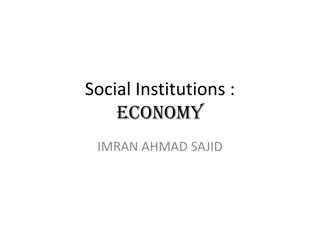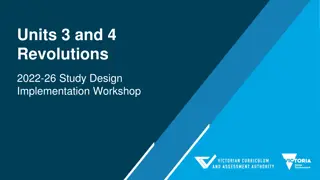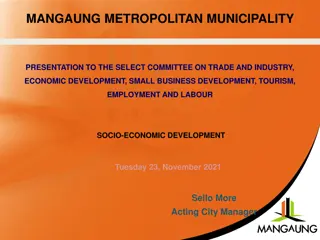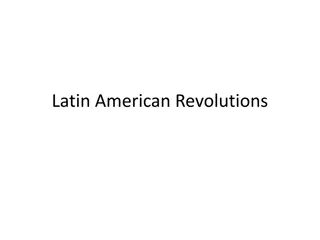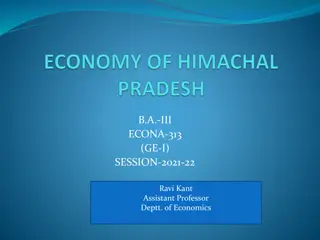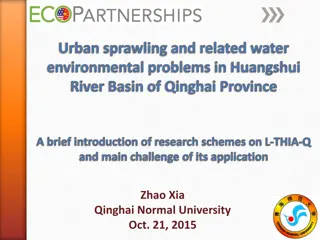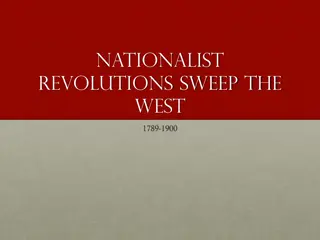Evolution of Industrial Revolutions in Agriculture: Free State Province Research & Program Director's Plannery Session
The presentation delves into the alignment of agriculture with the Fourth Industrial Revolution (4IR) in the Free State Province, tracing the evolution from the first to the third industrial revolutions. It discusses the advantages, disadvantages, impacts, competitiveness, opportunities, and threats of 4IR, culminating in a value-proposition alignment. Notable historical milestones in agricultural innovation are highlighted, emphasizing the transition towards modernization and technological integration.
Download Presentation

Please find below an Image/Link to download the presentation.
The content on the website is provided AS IS for your information and personal use only. It may not be sold, licensed, or shared on other websites without obtaining consent from the author. Download presentation by click this link. If you encounter any issues during the download, it is possible that the publisher has removed the file from their server.
E N D
Presentation Transcript
FREE STATE PROVINCE AGRICULTURE AND RURAL DEVELOPMENT: RESEARCH / PROGRAM 5 DIRECTORATE ALIGNENT OF AGRICULTURE TO THE FOURTH INDUSTRIAL REVOLUTION (4IR) PLANNERY SESSION PD Nchabeleng (Director) 19/08/2019
CONTENTS 1. Background to IR 2. Advantages of 4IR 3. Disadvantages of 4IR 4. Impact of 4IR 5. Competitiveness of the Free State Agricultural Sector 6. Opportunities 7. Threats 8. 4IR Value-Proposition Alignment 9. Concluding Remarks
Background to 1IR Background to 1IR Long before the conception of the Industrial Revolution or 1IR, agricultural sector began to revolutionize and industrialized around 3000BC, where wheel & axis were invented in Mesopotamia, today well known as Iraq; The 1st Industrial Revolution (1IR) dawned at around 1760 - 1840 (Iron ore for steel, coal for steam engine and textile were at the centre of development); Major exodus of migratory labour from rural countryside to the cities were experienced in developed countries); In 1816, a milking machine was inverted by Eli Whitney, inventor of Cotton gin at New Haven Connicticut in USA;
Background to 2IR Background to 2IR 2IR happened between 1870 and 1920, where lever machines were used as balance scale to move large objects in ancient Egyptian technology; In 1892, a gasoline powered tractor, which gave birth to a John Deere was born in 1949; Sasol for manufacturing of petro-chemicals incepted in 1950 in South Africa, which was 30 years after the elapse of 2IR, which ended in 1920; 2IR was science booming (internal combustion engines and automatons) and mass production era.
Background to 3IR Background to 3IR 3IR happened between 1969 - 2016, when renewable energies (nuclear, solar and wind were developed); Planes were also invented; Computation and robots inverted; After effects of 2IR (interphase between 2IR & 3IR) resulted in major exodus of migratory labour from rural countryside to the cities were experienced in developing countries, which happened in the early to meet 1900);
Background to 4IR Background to 4IR 4IR is defined as a current and developing environment in which the disruptive technologies and trends such as the: Internet of Things (IoT), Robotics, Virtual Reality (VR) and Artificial Intelligence (AI) are changing the way we leave and work and it improves human life. Agricultural Industrial Revolution of the 4IR zooms strictly at technology intelligence on efficiencies & precisioning in production.
Background to 4IR Background to 4IR 4IR had incepted in 2016 onwards and it includes the following: It describes the blurring/opaquesness of boundaries between the physical, digital and biological systems; Green economy (Climate Smart Agriculture (CSA) like Conservation Agriculture (CA) Practices and Bio-digesters, solar, wind, etc, for alternative energy sources.
Advantages of the 4IR Advantages of the 4IR 4IR Key Outcomes in Agric Sector are dependant upon Economic Transformation & Growth Strategy of the Sector Modernizing network industries ICT, Education, Energy and Water and environment; Lowering barriers to entry and addressing distorted patterns of ownership markets, physical infrastructure & natural resources; Prioritizing labour intensive industries agriculture and tourism; Flexible industrial and trade policy; Promoting local & export competitiveness and regional growth.
Advantages of the 4IR Advantages of the 4IR 4IR Key Outcomes in Agric Sector are dependant upon Economic Transformation & Growth Strategy of the Sector
Advantages of the 4IR Advantages of the 4IR Advantages of 4IR: Improves productivity; Flexibility; Efficiency; Reduces excess capacity; Eliminates many manual process;
Advantages of the 4IR Advantages of the 4IR Advantages of 4IR : Developing, diffusing and governing technologies to foster: Empowerment; Collaboration; Sustainable foundation for the social and economic development; Built around shared values of the common goal, human dignity and inter-generational stewardship.
Advantages of the 4IR Advantages of the 4IR Advantages of 4IR (part of financial investment) : Makkia, Thraen & Tweeten (1999), found rate of return to public R&D to be 27% while for privately funded R&D to be 5%, thus publicly funded R&D improves productivity aligned to the 4IR; Privately funded R&D lower rate of return is due to limited access to innovation because of secrecy and protection of information;
Disadvantages of the 4IR Disadvantages of the 4IR Disadvantages of 4IR: Deterioration of quality of life due to urbanization; Loss of individuality of the factory workers; The importance individual power is reduced in comparison to that of the equipment used for production; Huge number of people moved (exodus) out of the countryside to the big cities; Jobs often dangerous and pay less and people leave very low standard; Workers often leave in poor housing conditions;
Disadvantages of the 4IR Disadvantages of the 4IR Disadvantages of 4IR (influenced by budgeting): Public Agricultural R&D expenditure in SA has been declining by 3.28% in the past 3 years; During same time, privately funded agricultural R&D expenditure grew by 8.1% - mainly driven by commodity associations, which does not align to 4IR competitiveness of the Agricultural Sector;
Disadvantages of the 4IR Disadvantages of the 4IR Disadvantages of 4IR (influenced by Budgeting) In SA the Gross Fixed Capital Formation (GFCF) as percentage of value added in agriculture declined from an average of 27% in 1970s to 16% in the past decade In developed nations GFCF as a percentage of value- added is above 35% & in developing countries it is close to 28% on average. R&D Investments around 2.5% in developed nations of Agri-GDP, BUT around 0.5% of Agri-GDP in South Africa.
Disadvantages of the 4IR Disadvantages of the 4IR Disadvantages of 4IR (influenced by Investment Budgeting in RSA) : Figure 2:
Impact of 4IR Impact of 4IR Impact of 4IR: South Africa has the continent's most sophisticated economy, with a strong financial services industry and robust mobile market. But, with the world's largest reserves of gold, and significant mineral resources, much of the country's previous development has been linked to mining and manufacturing; It brings significant socio-economic changes; Increase in human population, which, along with an increase in living standards, lead to the depletion of natural resources; The use of chemicals and fuel in factories resulted in increased air and water pollution as a result of an increased use of fossil fuels.
Competitiveness of the FS Agric. Sector Competitiveness of the FS Agric. Sector National Ranking of Commodities from the Free State Province Crops / Plants (FS as Bread Basket of the country) Province Commodity Percentage Rating Free State Maize 44 % 1 // Sorghum 16,3 % 3 // Sunflower 51,9 % 1 // Drybeans 46,7 % 1 // Soyabeans 41,8 % 2 // Wheat (irrigation) 16 % 1 // Groundnuts 39,3 % 2 // Cherry 38 % 2
Competitiveness of the FS Agric. Sector Competitiveness of the FS Agric. Sector National Ranking of Commodities from the Free State Province Livestock Province Commodity Percentage Rating Free State Cattle 17,0 % 3 // Sheep 20 % 3 // Goats 4,15 % 6 // Pigs 7,97 % 6 // Poultry (Broiler) 5,8 % 8 // Poultry (Layers) 13,8 % 3 // Ostriches 41,8 % 2 // Milk 6,1 % 4 // Wool 21,0 % 2
Competitiveness of the FS Agric. Sector Competitiveness of the FS Agric. Sector FIGURE 3: TYPES OF RESEARCH APPLICABLE TO PUBLIC, PRIVATE, COMMUNITIES & UNIVERSITIES DOMAINS
Opportunities of 4IR in the AGRIC Sector Opportunities of 4IR in the AGRIC Sector The following are the 4IR opportunities: 1) Nanoscience / Nanotechnology Is the manipulation or self-assembly of individual atoms, molecules or compounds into structures to create materials and devices with new or vastly different properties. Nano structured catalysts of filters to increase the efficiency of pesticides & herbicides, thus: Allowing lower doses; Reduce environmental pollution; Clean up existing pollutants.
Opportunities of 4IR in the AGRIC Sector Opportunities of 4IR in the AGRIC Sector The following are the 4IR opportunities (Nanoscience / Nanotechnology): New materials and beneficial materials properties such as electric efficiency, shape retention and new functionality from by-products; Molecular treatment of diseases; Rapid diseases detection; Enhancing the ability of the of plants to absorb nutrients;
Opportunities of 4IR in the AGRIC Sector Opportunities of 4IR in the AGRIC Sector The following are the 4IR opportunities: 2) Biotechnology Genetic engineering and sequencing; Biological computational modelling; Seeds to be encapsulated with nano-menclatures to germinate when sufficient moisture is available; Nano-coating of seeds. .
Opportunities of 4IR in the AGRIC Sector Opportunities of 4IR in the AGRIC Sector The following are the 4IR opportunities: 3) Bio-prospecting Bio-economic value chain evaluations through components and agro-chemicals evaluations; Identify new bio-active compounds, medicinal properties or essential oils screening and detections; 4) Precisioning agriculture s minimize inputs and apply targeted actions; goal is to maximize output, costs, monitor environmental variables Efficient & precise production systems; Centralized data to determine soil & environmental conditions and plants development (Increased water use efficiency); Scaling up; Increase production & decrease inputs costs.
Threats of the 4IR in the AGRIC Sector Threats of the 4IR in the AGRIC Sector Threats of 4IR are: Individual human capital is compromised by high tech technologies like robotics, thus job losses; Rapid depletion of natural resources due to population explosion, no food production; Increased environment, air and water pollution, which affects the quality of life.
4IR Value proposition Alignment 4IR Value proposition Alignment The 2013 Bio-Economic Strategy of DHEST prioritises the following sectors at centre of revolutionizing and revitalizing the economy of South Africa: 1) Agriculture and Agro-Process Value Chain (RAAVC, Point No 1 of the 10 Point Plan of Government); 2) Pharmaceuticals; 3) Mining and beneficiation; 4) Manufacturing 5) Tourism and environment; .
4IR 4IR Agri Agri- -Value proposition Value proposition 1) Agriculture and Agro-Process value chain; Increased scales of production of various high potential grain crops and livestock due to area suitability; Agro-value-chain and process all locally produced commodities within the province like grains for animal feed, human food and precision farming; Bio-prospecting by identifying invader shrubs for economic and social benefits, e.g., Seriphium plumosum (Slangbos); Reclamation of all commodities that were regarded as highest potential decades ago, e.g., cherry, maize, soya, etc
Current Provincial skills development to match 4IR Current Provincial skills development to match 4IR International International Province Skill Area Number Total Under- Graduates 85 Post- Graduate 25 Free State // Agro- processing Veterinary Science Agric Economics Agric Engineering 110 38 0 38 // 2 0 2 // 20 0 20 Total 145 25 170
Current Provincial skills development to match 4IR Current Provincial skills development to match 4IR National National Province Skill Area Number Total Under- Graduates 5 1 2 Post- Graduate 0 0 0 Free State // // Animal Science Crop Science Agric Economics Agric Engineering Veterinary Science Agro- processing 5 1 2 // 20 0 20 17 0 17 2 0 2 Total 47 0 47
Concluding Remarks Concluding Remarks 1) Generally the Industrial Revolution refers to accelerated technological progress characterised by new innovations whose rapid application and diffusion causes an abrupt change in society; 2) 4IR is a total set of the Industrial Revolution taking into cognisance all the other previous industrial revolutions like 1IR, 2IR and 3IR; 3) Taking advantage of the skills being developed by the Executive Council of the Free State Provincial Government, where children are taken all over the world to study various industries within the sector, the province is ready to face 4IR.
RE A LEBOHA, ASANTE SANA, DANKIE, ENKOSI, SIYABONGA, RE A LEBOGA, OBRIGADO, MORAKOZE, Xie xie!!! https://encrypted-tbn2.gstatic.com/images?q=tbn:ANd9GcR6YVk2z_o6J6GpEOfmLwOEBBVSWB96t5qYcIfRxlsbSF2kAeMZSeeeq0M THANK YOU,













